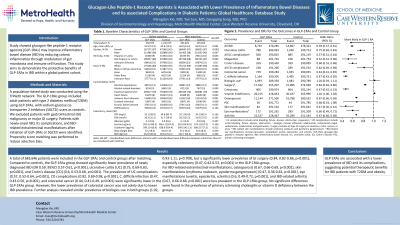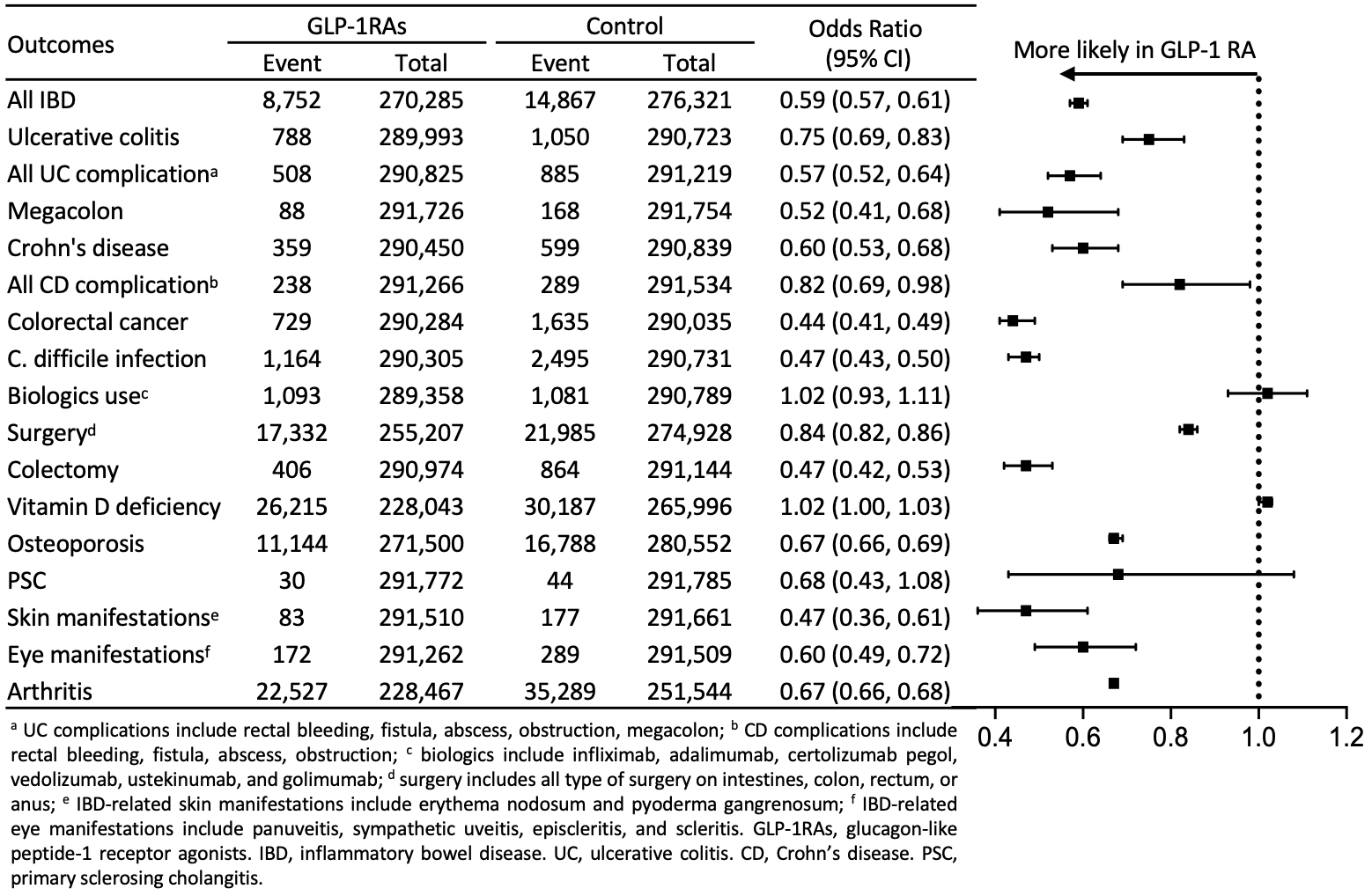Tuesday Poster Session
Category: IBD
P4388 - Glucagon-Like Peptide-1 Receptor Agonists is Associated with Lower Prevalence of Inflammatory Bowel Diseases and Its associated Complications in Diabetic Patients: Global Healthcare Database Study
Tuesday, October 29, 2024
10:30 AM - 4:00 PM ET
Location: Exhibit Hall E

Has Audio

Mengdan Xie, MD
Case Western Reserve University / MetroHealth
Cleveland, OH
Presenting Author(s)
Mengdan Xie, MD1, Yan Sun, MD1, Gengqing Song, MD, PhD2
1Case Western Reserve University / MetroHealth, Cleveland, OH; 2Metrohealth Medical Center, Cleveland, OH
Introduction: Study showed glucagon-like peptide-1 receptor agonists (GLP-1RAs) may improve inflammatory bowel disease (IBD) by reducing colonic inflammation through modulation of gut microbiota and immune cell function. This study aims to demonstrate the protective benefits of GLP-1RAs in IBD within a global patient cohort.
Methods: A population-based study was conducted using the TriNetX network. The GLP-1RAs group included adult patients with type 2 diabetes mellitus(T2DM) using GLP-1RAs, with sodium-glucose co-transporter 2 inhibitors (SGLT2i) users as controls. We excluded patients with gastrointestinal (GI) malignancy or major GI surgery. Patients with newly-onset IBD, its complications, and IBD-related extraintestinal manifestations after initiation of GLP-1RAs or SGLT2i were identified. Propensity score matching was performed to reduce selection bias.
Results: A total of 583,646 patients were included in the GLP-1RAs and control groups after matching. Compared to controls, the GLP-1RAs group showed significantly lower prevalence of newly diagnosed IBD (OR 0.59, 95%CI 0.57-0.61, p< 0.001), ulcerative colitis (UC) (0.75, 0.69-0.83, p< 0.001), and Crohn’s disease (CD) (0.6, 0.53-0.68, p< 0.001). The prevalence of UC complications (0.57, 0.52-0.64, p< 0.001), CD complications (0.82, 0.69-0.98, p< 0.001), C. difficile infection (0.47, 0.43-0.50, p< 0.001), and colorectal cancer (0.44, 0.41-0.49, p< 0.001) were significantly lower in the GLP-1RAs group. However, the lower prevalence of colorectal cancer was not solely due to lower IBD prevalence. Further analysis revealed similar prevalence of biologics use in both groups (1.02, 0.93-1.11, p=0.709), but a significantly lower prevalence of GI surgery (0.84, 0.82-0.86, p< 0.001), especially colectomy (0.47, 0.42-0.53, p< 0.001) in the GLP-1RAs group.
For IBD-related extraintestinal manifestations, osteoporosis (0.67, 0.66-0.69, p< 0.001), skin manifestations (erythema nodosum, pyoderma gangrenosum) (0.47, 0.36-0.61, p< 0.001), eye manifestations (uveitis, episcleritis, scleritis) (0.6, 0.49-0.72, p< 0.001), and IBD-related arthritis (0.67, 0.66-0.68, p< 0.001) were less prevalent in the GLP-1RAs group. No significant differences were found in the prevalence of primary sclerosing cholangitis or vitamin D deficiency between the groups.
Discussion: GLP-1RAs are associated with a lower prevalence of IBD and its complications, suggesting potential therapeutic benefits for IBD patients with T2DM and obesity.

Note: The table for this abstract can be viewed in the ePoster Gallery section of the ACG 2024 ePoster Site or in The American Journal of Gastroenterology's abstract supplement issue, both of which will be available starting October 27, 2024.
Disclosures:
Mengdan Xie, MD1, Yan Sun, MD1, Gengqing Song, MD, PhD2. P4388 - Glucagon-Like Peptide-1 Receptor Agonists is Associated with Lower Prevalence of Inflammatory Bowel Diseases and Its associated Complications in Diabetic Patients: Global Healthcare Database Study, ACG 2024 Annual Scientific Meeting Abstracts. Philadelphia, PA: American College of Gastroenterology.
1Case Western Reserve University / MetroHealth, Cleveland, OH; 2Metrohealth Medical Center, Cleveland, OH
Introduction: Study showed glucagon-like peptide-1 receptor agonists (GLP-1RAs) may improve inflammatory bowel disease (IBD) by reducing colonic inflammation through modulation of gut microbiota and immune cell function. This study aims to demonstrate the protective benefits of GLP-1RAs in IBD within a global patient cohort.
Methods: A population-based study was conducted using the TriNetX network. The GLP-1RAs group included adult patients with type 2 diabetes mellitus(T2DM) using GLP-1RAs, with sodium-glucose co-transporter 2 inhibitors (SGLT2i) users as controls. We excluded patients with gastrointestinal (GI) malignancy or major GI surgery. Patients with newly-onset IBD, its complications, and IBD-related extraintestinal manifestations after initiation of GLP-1RAs or SGLT2i were identified. Propensity score matching was performed to reduce selection bias.
Results: A total of 583,646 patients were included in the GLP-1RAs and control groups after matching. Compared to controls, the GLP-1RAs group showed significantly lower prevalence of newly diagnosed IBD (OR 0.59, 95%CI 0.57-0.61, p< 0.001), ulcerative colitis (UC) (0.75, 0.69-0.83, p< 0.001), and Crohn’s disease (CD) (0.6, 0.53-0.68, p< 0.001). The prevalence of UC complications (0.57, 0.52-0.64, p< 0.001), CD complications (0.82, 0.69-0.98, p< 0.001), C. difficile infection (0.47, 0.43-0.50, p< 0.001), and colorectal cancer (0.44, 0.41-0.49, p< 0.001) were significantly lower in the GLP-1RAs group. However, the lower prevalence of colorectal cancer was not solely due to lower IBD prevalence. Further analysis revealed similar prevalence of biologics use in both groups (1.02, 0.93-1.11, p=0.709), but a significantly lower prevalence of GI surgery (0.84, 0.82-0.86, p< 0.001), especially colectomy (0.47, 0.42-0.53, p< 0.001) in the GLP-1RAs group.
For IBD-related extraintestinal manifestations, osteoporosis (0.67, 0.66-0.69, p< 0.001), skin manifestations (erythema nodosum, pyoderma gangrenosum) (0.47, 0.36-0.61, p< 0.001), eye manifestations (uveitis, episcleritis, scleritis) (0.6, 0.49-0.72, p< 0.001), and IBD-related arthritis (0.67, 0.66-0.68, p< 0.001) were less prevalent in the GLP-1RAs group. No significant differences were found in the prevalence of primary sclerosing cholangitis or vitamin D deficiency between the groups.
Discussion: GLP-1RAs are associated with a lower prevalence of IBD and its complications, suggesting potential therapeutic benefits for IBD patients with T2DM and obesity.

Figure: Figure. Prevalence and Odds Ratios for the Outcomes in GLP-1RAs and Control Group
Note: The table for this abstract can be viewed in the ePoster Gallery section of the ACG 2024 ePoster Site or in The American Journal of Gastroenterology's abstract supplement issue, both of which will be available starting October 27, 2024.
Disclosures:
Mengdan Xie indicated no relevant financial relationships.
Yan Sun indicated no relevant financial relationships.
Gengqing Song indicated no relevant financial relationships.
Mengdan Xie, MD1, Yan Sun, MD1, Gengqing Song, MD, PhD2. P4388 - Glucagon-Like Peptide-1 Receptor Agonists is Associated with Lower Prevalence of Inflammatory Bowel Diseases and Its associated Complications in Diabetic Patients: Global Healthcare Database Study, ACG 2024 Annual Scientific Meeting Abstracts. Philadelphia, PA: American College of Gastroenterology.
